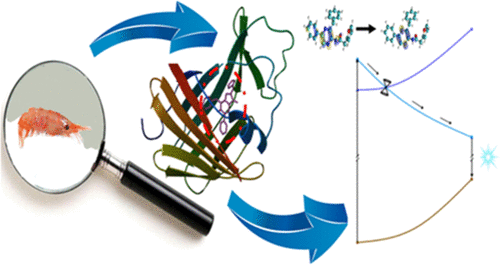当前位置:
X-MOL 学术
›
J. Phys. Chem. B
›
论文详情
Our official English website, www.x-mol.net, welcomes your feedback! (Note: you will need to create a separate account there.)
Bioluminescent Nanoluciferase–Furimamide Complex: A Theoretical Study on Different Protonation States
The Journal of Physical Chemistry B ( IF 3.3 ) Pub Date : 2020-03-23 , DOI: 10.1021/acs.jpcb.9b11597 Mehdi Sahihi 1 , Juan Sanz García 1 , Isabelle Navizet 1
The Journal of Physical Chemistry B ( IF 3.3 ) Pub Date : 2020-03-23 , DOI: 10.1021/acs.jpcb.9b11597 Mehdi Sahihi 1 , Juan Sanz García 1 , Isabelle Navizet 1
Affiliation

|
Luminescence of furimamide is 150 times brighter than oxidized luciferins in firefly and renilla luciferase. However, we do not have a clear understanding of the structure, function, and dynamic behavior of the nanoluciferase–furimamide complex. Here, for the first time, the absorption and emission properties of eight different possible light emitter forms of furimamide were investigated using the time-dependent density functional theory (TD-DFT) method in the gas phase and aqueous solution. The emission oscillator strengths in the gas phase showed that emission transition may be forbidden for some forms, and fluorescence would not occur. Besides, the charge transfer (CT) as well as the orbitals involved in the transitions were analyzed. Furthermore, molecular docking results showed that furimamide is situated inside the central cavity (β-barrel) of nanoluciferase. Analysis of the trajectory of molecular dynamics (MD) simulations suggested a less compact structure of protein in the presence of furimamide in comparison to its apo form. The quantum mechanical/molecular mechanical (QM/MM) spectroscopic properties of one form in the binding site of nanoluciferase were investigated. The evolution of the excited states (ESs) of furimamide in the binding pocket of the protein confirmed that after photoexcitation and during the relaxation of the system, a crossing point between the first two singlet ESs exists. Thus, the initially populated S2 (a π→π* transition) becomes the first singlet excited state.
中文翻译:

生物发光纳米荧光素酶-富马酰胺复合物:不同质子化状态的理论研究
在萤火虫和海肾荧光素酶中,呋喃酰胺的发光强度比氧化荧光素高150倍。但是,我们对纳米萤光素酶-呋喃酰胺复合物的结构,功能和动力学行为没有清晰的了解。在这里,首次使用时变密度泛函理论(TD-DFT)方法研究了八种不同形式的呋喃酰胺的吸收和发射特性在气相和水溶液中的吸收特性。气相中的发射振荡器强度表明,某些形式可能禁止发射跃迁,并且不会发生荧光。此外,分析了电荷转移(CT)以及跃迁中涉及的轨道。此外,分子对接结果表明,呋喃酰胺位于纳米荧光素酶的中心腔(β-桶)内。分子动力学(MD)模拟轨迹的分析表明,与呋喃酰胺的载脂蛋白形式相比,在存在呋喃酰胺的情况下蛋白质的结构不太紧凑。研究了纳米荧光素酶结合位点中一种形式的量子力学/分子力学(QM / MM)光谱特性。呋喃酰胺在蛋白质结合口袋中的激发态(ESs)的演变证实,在光激发后和系统松弛期间,前两个单线态ES之间存在交叉点。因此,最初填充的S2(π→π*跃迁)成为第一单重态激发态。分子动力学(MD)模拟轨迹的分析表明,与呋喃酰胺相比,在呋喃酰胺存在下蛋白质的结构不太紧凑。研究了纳米荧光素酶结合位点中一种形式的量子力学/分子力学(QM / MM)光谱特性。呋喃酰胺在蛋白质结合口袋中的激发态(ESs)的演变证实,在光激发后和系统松弛期间,前两个单线态ES之间存在交叉点。因此,最初填充的S2(π→π*跃迁)成为第一单重态激发态。分子动力学(MD)模拟轨迹的分析表明,与呋喃酰胺相比,在呋喃酰胺存在下蛋白质的结构不太紧凑。研究了纳米荧光素酶结合位点中一种形式的量子力学/分子力学(QM / MM)光谱特性。呋喃酰胺在蛋白质结合口袋中的激发态(ESs)的演变证实,在光激发后和系统松弛期间,前两个单线态ES之间存在交叉点。因此,最初填充的S2(π→π*跃迁)成为第一单重态激发态。研究了纳米荧光素酶结合位点中一种形式的量子力学/分子力学(QM / MM)光谱特性。呋喃酰胺在蛋白质结合口袋中的激发态(ESs)的演变证实,在光激发后和系统松弛期间,前两个单线态ES之间存在交叉点。因此,最初填充的S2(π→π*跃迁)成为第一单重态激发态。研究了纳米荧光素酶结合位点中一种形式的量子力学/分子力学(QM / MM)光谱特性。呋喃酰胺在蛋白质结合口袋中的激发态(ESs)的演变证实,在光激发后和系统松弛期间,前两个单线态ES之间存在交叉点。因此,最初填充的S2(π→π*跃迁)成为第一单重态激发态。
更新日期:2020-03-24
中文翻译:

生物发光纳米荧光素酶-富马酰胺复合物:不同质子化状态的理论研究
在萤火虫和海肾荧光素酶中,呋喃酰胺的发光强度比氧化荧光素高150倍。但是,我们对纳米萤光素酶-呋喃酰胺复合物的结构,功能和动力学行为没有清晰的了解。在这里,首次使用时变密度泛函理论(TD-DFT)方法研究了八种不同形式的呋喃酰胺的吸收和发射特性在气相和水溶液中的吸收特性。气相中的发射振荡器强度表明,某些形式可能禁止发射跃迁,并且不会发生荧光。此外,分析了电荷转移(CT)以及跃迁中涉及的轨道。此外,分子对接结果表明,呋喃酰胺位于纳米荧光素酶的中心腔(β-桶)内。分子动力学(MD)模拟轨迹的分析表明,与呋喃酰胺的载脂蛋白形式相比,在存在呋喃酰胺的情况下蛋白质的结构不太紧凑。研究了纳米荧光素酶结合位点中一种形式的量子力学/分子力学(QM / MM)光谱特性。呋喃酰胺在蛋白质结合口袋中的激发态(ESs)的演变证实,在光激发后和系统松弛期间,前两个单线态ES之间存在交叉点。因此,最初填充的S2(π→π*跃迁)成为第一单重态激发态。分子动力学(MD)模拟轨迹的分析表明,与呋喃酰胺相比,在呋喃酰胺存在下蛋白质的结构不太紧凑。研究了纳米荧光素酶结合位点中一种形式的量子力学/分子力学(QM / MM)光谱特性。呋喃酰胺在蛋白质结合口袋中的激发态(ESs)的演变证实,在光激发后和系统松弛期间,前两个单线态ES之间存在交叉点。因此,最初填充的S2(π→π*跃迁)成为第一单重态激发态。分子动力学(MD)模拟轨迹的分析表明,与呋喃酰胺相比,在呋喃酰胺存在下蛋白质的结构不太紧凑。研究了纳米荧光素酶结合位点中一种形式的量子力学/分子力学(QM / MM)光谱特性。呋喃酰胺在蛋白质结合口袋中的激发态(ESs)的演变证实,在光激发后和系统松弛期间,前两个单线态ES之间存在交叉点。因此,最初填充的S2(π→π*跃迁)成为第一单重态激发态。研究了纳米荧光素酶结合位点中一种形式的量子力学/分子力学(QM / MM)光谱特性。呋喃酰胺在蛋白质结合口袋中的激发态(ESs)的演变证实,在光激发后和系统松弛期间,前两个单线态ES之间存在交叉点。因此,最初填充的S2(π→π*跃迁)成为第一单重态激发态。研究了纳米荧光素酶结合位点中一种形式的量子力学/分子力学(QM / MM)光谱特性。呋喃酰胺在蛋白质结合口袋中的激发态(ESs)的演变证实,在光激发后和系统松弛期间,前两个单线态ES之间存在交叉点。因此,最初填充的S2(π→π*跃迁)成为第一单重态激发态。



























 京公网安备 11010802027423号
京公网安备 11010802027423号